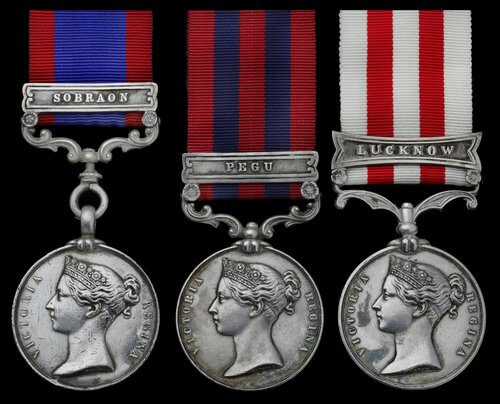
Auction: 21001 - Orders, Decorations and Medals (conducted behind closed doors)
Lot: 425
Three: Serjeant-Major T. Bulkley, European Bengal Fusiliers, late 40th Begnal Native Infantry and Nusseeree Battalion
Sutlej 1845-46, for Aliwal, 1 clasp, Sobraon (Qr. Mr. Serjt. T: Buckley [sic] Nusseeree Battn.), suspension replaced with swivelling loop, with clasp affixed; India General Service 1854-95, 1 clasp, Pegu (Serjt. Majr. Timy. Bulkley. 40th Regt. N.I.); Indian Mutiny 1857-59, 1 clasp, Lucknow (Timy. Bulkley, 1st. Eurn. Bengal Fusrs.), first worn, good fine, remainder very fine and a rare combination (3)
Timothy Bulkley served at the Battle of Aliwal with the Nusseeree Battalion (later to become 1st Gurkha Rifles) which was part of Brigadier-General Godby's Brigade and Major-General Sir Harry Smith's Division, who decided that his best plan was to crush the Sikh left and centre and capture Aliwal as the key position. Quickly bringing up Godby's Brigade he made a rapid charge and carried the village of Aliwal. After his victory of Aliwal, Major-General Smith re-joined the main army in front of Sobraon, where it was facing the great Sikh entrenched bridgehead on the left bank of the Sutlej. After two hours of artillery bombardment, which had not done much harm to the enemy's entrenchments and with ammunition running short, it was deemed necessary to launch the attack. Major-General Smith's Division now advanced, but found in front of them the strongest part of the Sikh's entrenchments, with great continuous ramparts and broad deep ditches in front of them. To the left of the division was the Nusseeree Battalion moving just to the right of the village of Sobraon, which was outside the Sikh entrenchments. The Division reeled for a moment under the storm of shot and shell, grape and musketry, which fell upon them at short range. Reforming, it once again advanced and despite the desperate gallantry of the Sikh Army, the Army of the Sutlej pressed steadily forward through the entrenchments, sweeping the defenders back to the river. The victory was complete and the Sikhs suffered terribly from the British artillery as they sought to get across the river. Again, as at Aliwal, the conduct of the Goorkhas had excited admiration of the superior commanders. The despatch of the Commander-in-Chief, Sir Hugh Gough, contains the following passage:
'I must pause in this narrative especially to notice the determined hardihood and bravery with which our two battalions of Goorkhas, the Sirmoor and Nusseree, met the Sikhs wherever they were opposed to them. Soldiers of small stature but indomitable spirit, they vied in ardent courage in the charge with the Grenadiers of our own nation, and, armed with the short weapon of their mountains (i.e. kukri), were a terror to the Sikhs throughout this great combat.'
To assist the small cadre of British Officers in each regiment of the Honourable East India Company, two British Non-Commissioned Officers - being one Sergeant-Major and one Quartermaster-Sergeant were attached. These appointments appear to have been abolished with the re-organisation of the Bengal Native Army in 1861. However, there is no mention of such appointments or of Quartermaster Sergeant Buckley in the history of 1st King George's Own Gurkha Rifles (The Malaun Regiment).
Subject to 20% VAT on Buyer’s Premium. For more information please view Terms and Conditions for Buyers.
Sold for
£1,200
Starting price
£400




